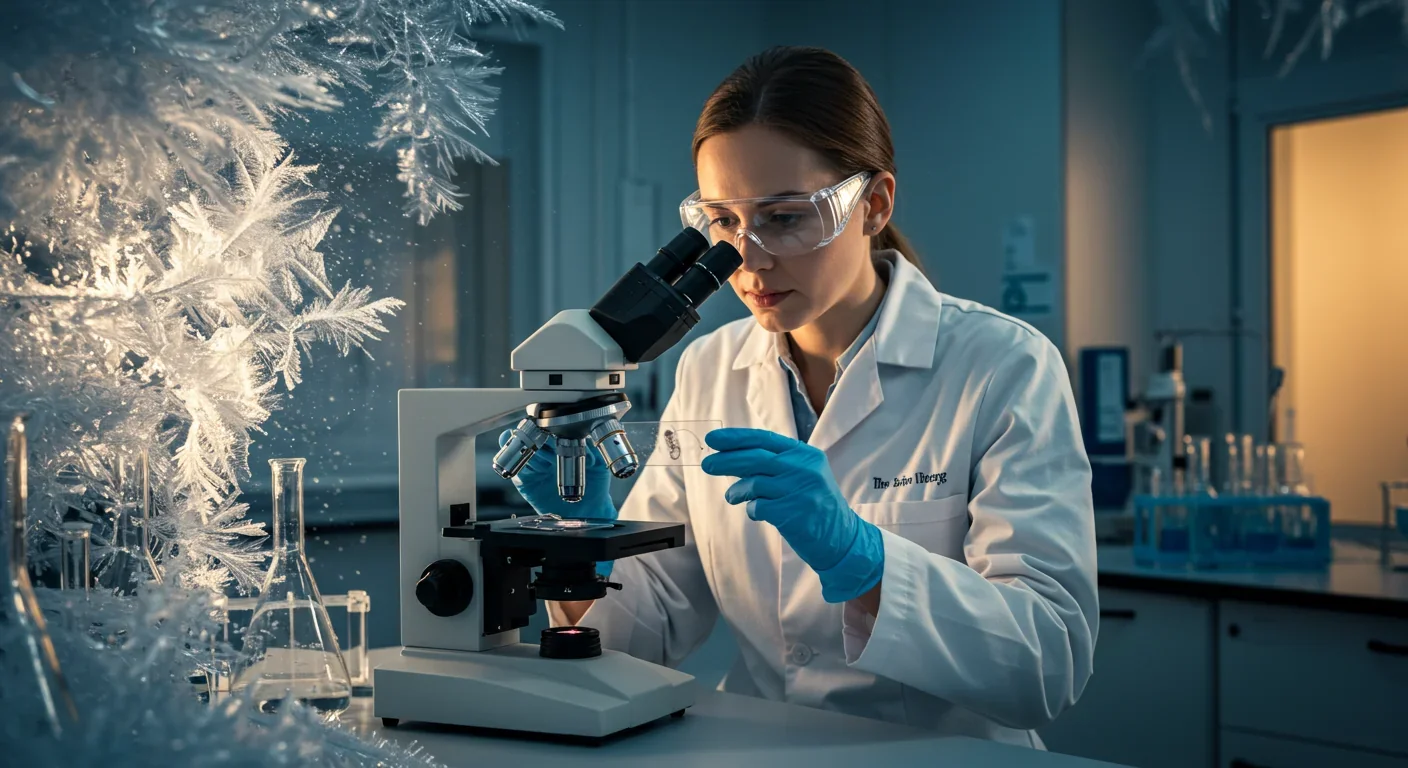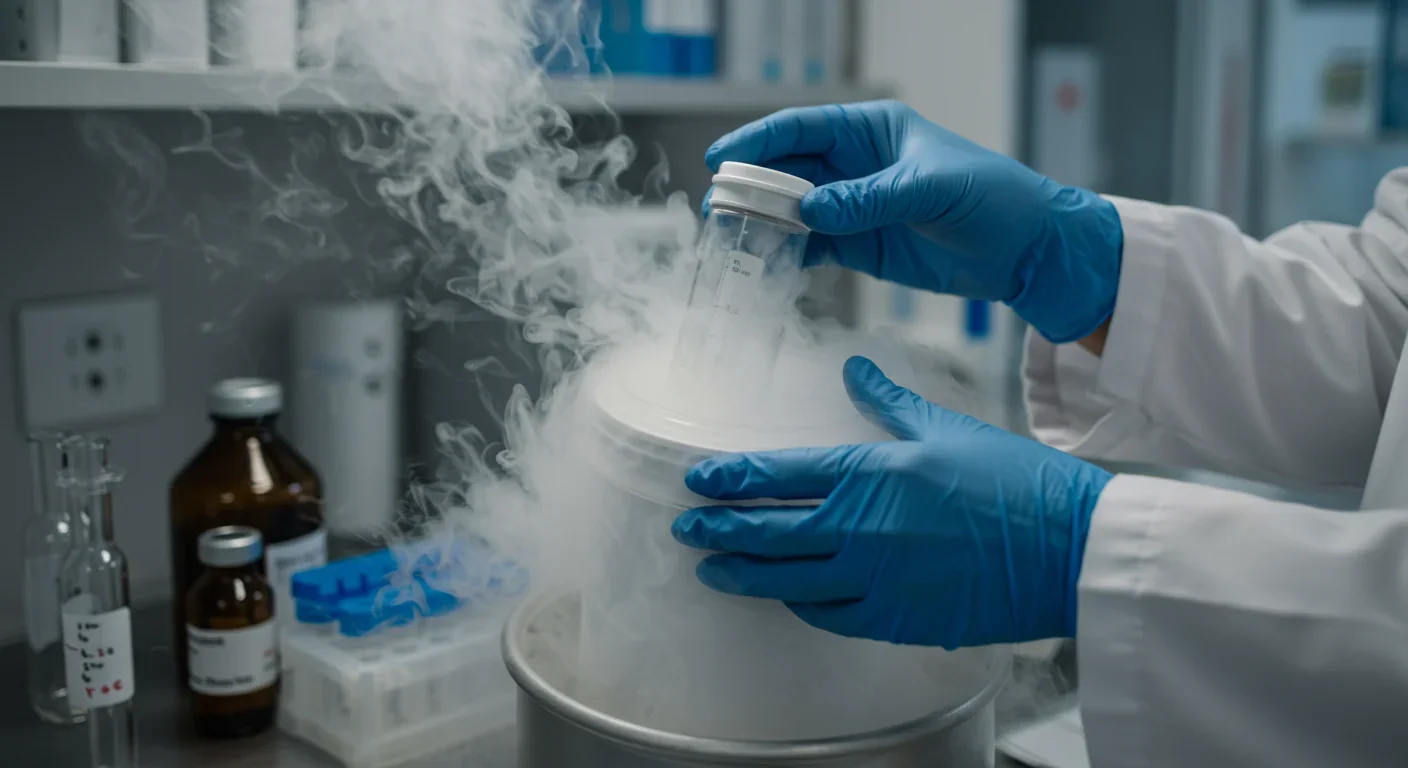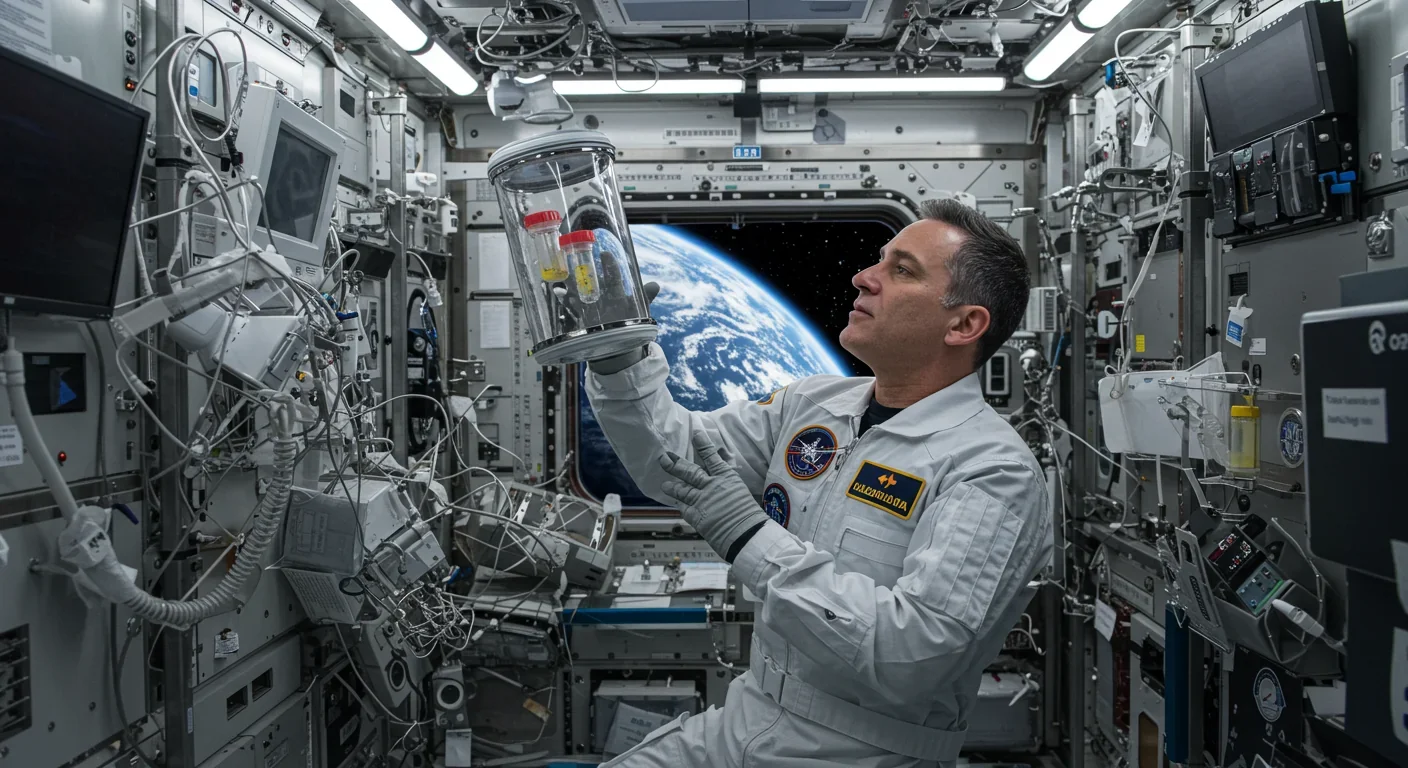Bombardier Beetle Chemical Defense: Nature's Micro Engine

TL;DR: Cryptobiosis allows organisms like tardigrades and nematodes to survive extreme conditions by entering suspended animation. This natural phenomenon could revolutionize organ preservation, space travel, and vaccine stability.

Imagine being frozen for 46,000 years, then waking up, having a meal, and making babies. That's not science fiction—it's what a tiny nematode worm did after scientists extracted it from Siberian permafrost in 2023. The worm, Panagrolaimus kolymaensis, survived millennia in a state of suspended animation called cryptobiosis, a biological superpower that lets certain organisms hit pause on life itself.
This ability to enter reversible dormancy isn't limited to one lucky worm. Tardigrades can survive temperatures from near absolute zero to 302°F, the vacuum of space, and radiation doses that would kill almost anything else on Earth. Brine shrimp eggs lie dormant for decades before hatching. Bdelloid rotifers revive after 24,000 years frozen in permafrost.
The implications reach far beyond cool biology facts. Understanding how these organisms cheat death could revolutionize organ transplantation, enable interstellar travel, and transform how we preserve everything from vaccines to endangered species. Nature has already solved problems that humanity desperately needs answers to—we just need to learn the language.
Cryptobiosis literally means "hidden life." It's a state where metabolism drops to undetectable levels, sometimes ceasing entirely. The organism becomes ametabolic—not dead, not alive in the traditional sense, but suspended between the two.
There are several types of cryptobiosis, each triggered by different environmental stresses:
Anhydrobiosis happens when water disappears. Organisms expel nearly all moisture from their cells and enter a dehydrated state that can last years. Tardigrades master this form, shrinking into a structure called a "tun" that resembles a tiny barrel.
Cryobiosis is triggered by freezing temperatures. As ice crystals form, organisms protect their cells from damage through specialized proteins and sugars. The 46,000-year-old worm survived through cryobiosis in permafrost that never thawed.
Anoxybiosis occurs during oxygen deprivation. Some nematodes and tardigrades can survive extended periods without oxygen by halting aerobic metabolism entirely.
Osmobiosis protects against extreme salinity changes. Brine shrimp embryos use this strategy, withstanding salt concentrations that would kill most organisms.
The common thread? These aren't adaptations to thrive in harsh conditions—they're strategies to wait them out. Evolution favored the patient.
These eight-legged micro-animals, typically 0.5mm long, have become celebrities of extreme survival. Their secret lies in their ability to replace up to 97% of their body water with a crystalline matrix.
When conditions deteriorate, tardigrades retract their legs and head, forming the tun state. In this configuration, they've survived:
Temperatures down to -272°C (near absolute zero)
Heat up to 150°C (302°F)
Pressure six times greater than the deepest ocean trenches
Radiation 1,000 times the lethal dose for humans
The vacuum and radiation of outer space
That last point isn't theoretical. In 2007, the European Space Agency's FOTON-M3 mission exposed tardigrades to open space for 10 days. Despite facing conditions that kill almost everything within seconds, the tardigrades revived with ease once rehydrated back on Earth.
Scientists have identified that Milnesium tardigradum can theoretically survive over six years through repeated cycles of anhydrobiosis, though their active lifespan averages just 40 days. The discrepancy reveals cryptobiosis's real power: it doesn't just protect—it stops the aging clock.
The 46,000-year-old worm revival represents the longest confirmed multicellular survival in cryptobiosis. Researchers from the University of Cologne extracted the specimen from 120 feet underground, where it had been encased in ice since the Pleistocene epoch—when woolly mammoths still roamed Siberia.
After thawing, the worm didn't just survive. It ate. It moved. It reproduced. Its genome revealed unique adaptations that allowed cellular machinery to withstand ice crystal formation without catastrophic damage.
"No one had thought this process could last millennia," said Dr. Philipp Schiffer, one of the researchers. "It is simply amazing that life can begin again after so long."

These microscopic aquatic animals may look delicate, but they're nearly indestructible. In 2021, scientists revived bdelloid rotifers frozen for 24,000 years in Siberian permafrost. Unlike many organisms, rotifers can also repair extensive DNA damage accumulated during dormancy.
Their resistance to radiation makes them particularly interesting for space research. While cosmic rays fragment genetic material in most organisms, rotifers possess mechanisms to patch broken chromosomes back together.
Artemia species produce eggs that can survive decades in anhydrobiosis. These cysts withstand complete desiccation, and when water returns, they hatch within hours.
This reliability has made brine shrimp essential in aquaculture and scientific research. But it also demonstrates how cryptobiosis can serve as a life history strategy, not just an emergency response.
How do cells survive without water? How does DNA remain intact after 46,000 years? The mechanisms involve sophisticated molecular engineering that scientists are only beginning to understand.
Tardigrades produce proteins called CAHS (Cytoplasmic Abundant Heat Soluble) and SAHS that act as molecular scaffolding. These proteins form gel-like networks that stabilize cellular structures when water is removed.
Think of it like packing fragile dishes. Without padding, they shatter during transport. CAHS proteins provide that padding at a microscopic scale, preventing membranes and organelles from collapsing.
Many cryptobiotic organisms produce trehalose, a disaccharide that replaces water molecules around proteins and membranes. This sugar forms glass-like structures that preserve cellular architecture.
Trehalose is already used commercially to stabilize vaccines and biological samples. But organisms produce it naturally in concentrations that would be toxic to most life—another adaptation that makes cryptobiosis possible.
Radiation and time both damage genetic material. Cryptobiotic organisms have enhanced DNA repair systems that fix breaks and mutations upon reactivation.
Rotifers, for instance, can reassemble fragmented chromosomes after radiation exposure that would be instantly lethal to humans. This isn't just survival—it's cellular resurrection.
True cryptobiosis requires metabolic activity to cease almost completely. Organisms achieve this through:
Reducing ATP production to near zero
Sequestering reactive oxygen species that would otherwise cause damage
Halting gene expression and protein synthesis
Suppressing cellular respiration
The result is biological stasis. A tardigrade in the tun state might have a metabolic rate of 0.01% of its active level. Time, effectively, stops.
The practical implications of understanding cryptobiosis span from medicine to space colonization. These aren't distant possibilities—research is already underway.
Currently, human organs survive only hours outside the body. A heart lasts four to six hours. Lungs deteriorate even faster. This narrow window creates a logistics nightmare and limits who can receive transplants.
If we could induce a cryptobiotic-like state in organs, preservation time could extend dramatically. Research at the proteomic and genomic levels is exploring how tardigrade proteins might stabilize mammalian cells.
Early experiments have already preserved rat organs for extended periods using techniques inspired by anhydrobiosis. The challenge is scaling this to human organs without causing damage during the preservation or revival process.
Many vaccines require constant refrigeration, a challenge in regions without reliable electricity. Trehalose-based stabilization could allow vaccines to survive at room temperature or even elevated heat.
This isn't hypothetical. Some vaccines already use trehalose. But understanding the full suite of protective mechanisms from cryptobiotic organisms could lead to even more robust formulations.
Long-duration space travel poses biological problems we haven't solved. Cosmic radiation damages DNA, increasing cancer risk. Muscle and bone deteriorate in microgravity. Psychological stress of multi-year missions takes a toll.
Tardigrades have already proven they can survive the vacuum of space. If we could borrow their radiation resistance, astronauts might withstand the journey to Mars or beyond.
More radically, induced cryptobiosis could allow "suspended animation" for interstellar travel. Put crew members into metabolic stasis for decades, wake them when the destination approaches. It sounds like science fiction, but the biological blueprint already exists in nature.

Seed banks preserve plant genetics for future generations. But what about animal diversity? Cryptobiotic techniques could allow long-term storage of embryos, eggs, and even live specimens.
This becomes crucial as climate change threatens species faster than conservation efforts can protect them. A library of suspended organisms could serve as an insurance policy against extinction.
Despite the promise, significant obstacles remain before cryptobiosis translates to practical human use.
Tardigrades are microscopic. Nematodes are tiny. Scaling protective mechanisms to organisms as large and complex as humans presents enormous challenges.
Larger organisms have circulatory systems, diverse tissue types, and complex organs. Inducing uniform cryptobiosis across all these systems simultaneously is far more difficult than preserving a single-cell layer.
The most dangerous moments aren't necessarily during cryptobiosis itself—they're entering and exiting the state. Ice crystal formation during freezing can rupture cell membranes. Rehydration can cause osmotic shock.
Even organisms naturally capable of cryptobiosis sometimes fail to revive. Success rates vary by species and conditions. For medical applications, we'd need near-perfect reliability.
The 46,000-year-old worm successfully reproduced, but we don't know if prolonged cryptobiosis introduces subtle mutations or cellular damage that manifest over generations.
For human applications, any cryptobiotic technique would need extensive testing to ensure safety. Regulatory approval would require evidence that preservation and revival don't compromise long-term health.
If we could preserve humans in cryptobiosis, who gets access? Would it become a tool for the wealthy to skip forward through time? Could it create new forms of inequality?
And what about consent? If the technology allows preservation of critically ill patients until cures are developed, when is it appropriate to use? These questions don't have easy answers.
Current research focuses on identifying and isolating the key molecules that enable cryptobiosis, then testing whether they function in non-cryptobiotic organisms.
Some scientists are engineering bacteria to produce tardigrade proteins, testing whether these molecules can protect cells from stress. Early results show promise—cells with tardigrade proteins survive desiccation better than controls.
If we can identify the minimal genetic toolkit for cryptobiosis, could we transfer those genes to other organisms? The technical challenges are substantial, but the potential payoff is enormous.
Rather than modifying organisms directly, another approach is creating synthetic materials that mimic cryptobiotic mechanisms. Polymer gels that behave like CAHS proteins, or engineered sugars that improve on trehalose, could protect biological materials without genetic modification.
Cryptobiosis forces us to reconsider fundamental questions: What is life? What separates living from non-living? If an organism has no metabolism, no growth, no response to stimuli—but can return to full function when conditions improve—is it alive during dormancy?
These aren't just philosophical puzzles. The answers shape how we regulate biotechnology, define medical ethics, and understand our place in the cosmos.
The organisms capable of cryptobiosis have existed for millions of years. Tardigrades have survived five mass extinction events. While dinosaurs came and went, these microscopic survivors persisted through ice ages, asteroid impacts, and dramatic climate shifts.
Their strategy wasn't competition or conquest. It was patience. The ability to endure, to wait out catastrophe, to emerge when conditions improved.
We're still in the early stages of understanding cryptobiosis at a molecular level. Each new study reveals additional layers of complexity. The 46,000-year-old worm's genome, for instance, showed unexpected genes that researchers are still characterizing.
But progress is accelerating. Advances in genetic sequencing, protein analysis, and synthetic biology provide tools previous generations lacked. What seemed impossible a decade ago—reviving organisms frozen for tens of thousands of years—is now documented fact.
The next decade will likely bring:
More detailed molecular maps of cryptobiotic mechanisms
Successful preservation of complex tissues using biomimetic approaches
Possibly the first trials of induced cryptobiotic states in mammalian models
New discoveries of cryptobiotic species in extreme environments
Each breakthrough brings us closer to practical applications. The worm that survived 46,000 years in permafrost isn't just a curiosity—it's a proof of concept.
The story of cryptobiosis is ultimately about possibility. For most of human history, death was inevitable and permanent. Organs failed, and that was that. Preservation meant deterioration. Travel beyond our solar system seemed physically impossible given human lifespans.
But nature has already solved these problems. Life found ways to cheat death, to pause time, to endure conditions that should be instantly fatal.
We're not trying to invent something new. We're trying to understand and apply solutions that evolution has refined over hundreds of millions of years.
The tiny tardigrade surviving in the vacuum of space isn't just remarkable—it's instructional. The frozen worm waking after 46 millennia isn't just a scientific oddity—it's a roadmap.
These organisms survived because they could wait. They endured because they mastered the art of suspended existence. And in learning their secrets, we might just discover how to overcome some of humanity's most fundamental limitations.
The future might belong not to those who burn brightest, but to those who know when to pause the flame and wait for better conditions. Nature has been trying to teach us that lesson for millions of years.
Maybe now we're finally ready to listen.

Recent breakthroughs in fusion technology—including 351,000-gauss magnetic fields, AI-driven plasma diagnostics, and net energy gain at the National Ignition Facility—are transforming fusion propulsion from science fiction to engineering frontier. Scientists now have a realistic pathway to accelerate spacecraft to 10% of light speed, enabling a 43-year journey to Alpha Centauri. While challenges remain in miniaturization, neutron management, and sustained operation, the physics barriers have ...

Epigenetic clocks measure DNA methylation patterns to calculate biological age, which predicts disease risk up to 30 years before symptoms appear. Landmark studies show that accelerated epigenetic aging forecasts cardiovascular disease, diabetes, and neurodegeneration with remarkable accuracy. Lifestyle interventions—Mediterranean diet, structured exercise, quality sleep, stress management—can measurably reverse biological aging, reducing epigenetic age by 1-2 years within months. Commercial ...

Data centers consumed 415 terawatt-hours of electricity in 2024 and will nearly double that by 2030, driven by AI's insatiable energy appetite. Despite tech giants' renewable pledges, actual emissions are up to 662% higher than reported due to accounting loopholes. A digital pollution tax—similar to Europe's carbon border tariff—could finally force the industry to invest in efficiency technologies like liquid cooling, waste heat recovery, and time-matched renewable power, transforming volunta...

Humans are hardwired to see invisible agents—gods, ghosts, conspiracies—thanks to the Hyperactive Agency Detection Device (HADD), an evolutionary survival mechanism that favored false alarms over fatal misses. This cognitive bias, rooted in brain regions like the temporoparietal junction and medial prefrontal cortex, generates religious beliefs, animistic worldviews, and conspiracy theories across all cultures. Understanding HADD doesn't eliminate belief, but it helps us recognize when our pa...

The bombardier beetle has perfected a chemical defense system that human engineers are still trying to replicate: a two-chamber micro-combustion engine that mixes hydroquinone and hydrogen peroxide to create explosive 100°C sprays at up to 500 pulses per second, aimed with 270-degree precision. This tiny insect's biochemical marvel is inspiring revolutionary technologies in aerospace propulsion, pharmaceutical delivery, and fire suppression. By 2030, beetle-inspired systems could position sat...

The U.S. faces a catastrophic care worker shortage driven by poverty-level wages, overwhelming burnout, and systemic undervaluation. With 99% of nursing homes hiring and 9.7 million openings projected by 2034, the crisis threatens patient safety, family stability, and economic productivity. Evidence-based solutions—wage reforms, streamlined training, technology integration, and policy enforcement—exist and work, but require sustained political will and cultural recognition that caregiving is ...

Every major AI model was trained on copyrighted text scraped without permission, triggering billion-dollar lawsuits and forcing a reckoning between innovation and creator rights. The future depends on finding balance between transformative AI development and fair compensation for the people whose work fuels it.